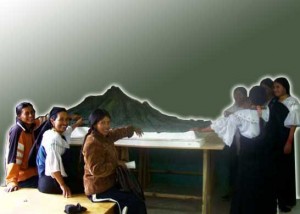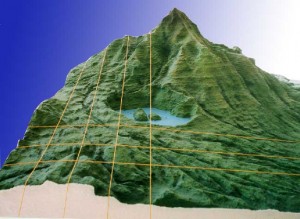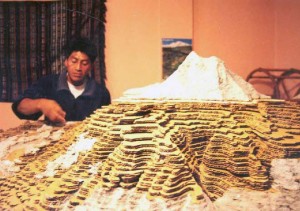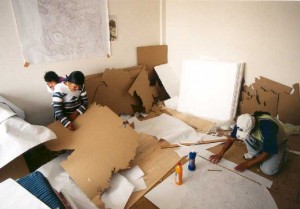Participatory 3D Model of the Cotacachi Volcano and the Greater Ambi River Watershed, Imbabura, Ecuador


This 10,000-scale 3D model was completed in 2003. It covers a total area of 28,000 ha which includes three small tributaries feeding into the Greater Ambi River.
In this area there are 43 indigenous communities that greatly depend on the natural resource base for their subsistence.
The P3DM exercise was done in order to promote sustainable practices in agriculture and collaborative natural resource management, all building on local knowledge and input.
In the SANREM Ecuadorian site, this process began in January 2003 as a collaborative activity between SANREM, the Ministry of Agriculture of Ecuador, and UNORCAC, a local federation of indigenous communities (Union de Organizaciones Campesinas de Cotacachi).


The process was coordinated by the SANREM Site SANREM CRSP ResearchImpacts Reality 3D: Innovative Representations of an Andean Landscape The bare layers of cardboard give the maqueta its 3-dimentionality Coordinator Shiloh Moates. Several meetings were held during which stakeholders discussed and decided what to include in the model as well as its appropriate scale and size.
As a catalyst of information exchange and analytical reflection, the maqueta constitutes a powerful instrument for social learning, consensus building, and participatory development.
In the future, the SANREM-Andes team plans to use the maqueta in the course of future visioning workshops to elicit local stakeholders’ perceptions of environmental change and imagined scenarios of a desirable future, and in the course of focus groups on social history to stimulate local people’s recollections of the past hacienda system and of the establishment of indigenous communities.
Recommended readings:
Rhoades B. and Shiloh Moates A. 2003. Reality 3D: Innovative Representations of an Andean Landscape. SANREM CRSP Research Impacts.
Robert E. Rhoades. 2006. Sustainability Science in Indigenous Communities: Reconciling Local and Global Agendas University of Georgia, Department of Anthropology, 250 Baldwin Hall, Athens, GA 30602, USA
Follow us!